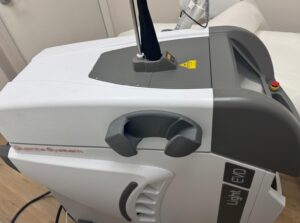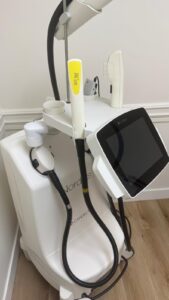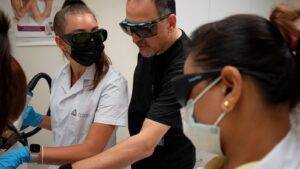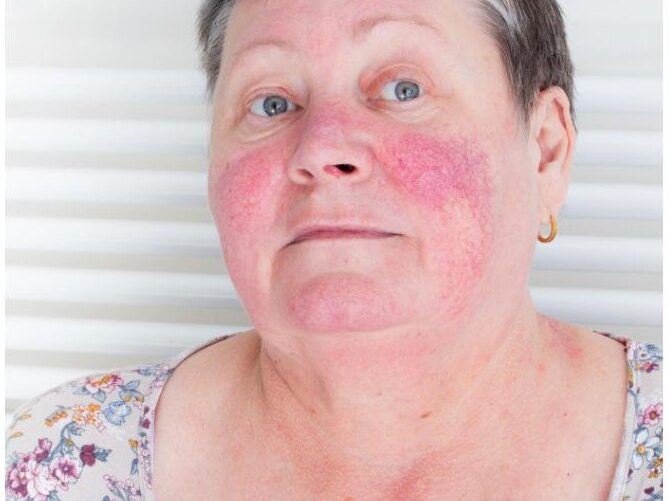Rosacea: Vascular Laser platforms and IPL Treatments
 Faramarz Rafie MD / Vancoderm Academy [VDA] / Vancoderm Clinic [VDCMed]
Faramarz Rafie MD / Vancoderm Academy [VDA] / Vancoderm Clinic [VDCMed]
Rosacea is a chronic and often frustrating skin condition that affects millions of people worldwide. It primarily manifests on the central face and occasionally the neck, scalp, and eyes, causing persistent redness, visible capillaries, sensitivity, and sometimes acne-like bumps. It usually occurs between 20 and 50 years with female preponderance, however, men more frequently progress to the end stages of severe rosacea. The exact cause of rosacea remains unclear, but it is believed to result from a combination of genetic factors, overactive immune responses, and environmental triggers. Flare-ups are commonly associated with sunlight exposure, stress, spicy foods, alcohol consumption, and extreme weather conditions. Because it is a long-term condition, proper management is essential to reduce symptoms and improve skin appearance.
Rosacea is generally divided into four subtypes, though many individuals may present with overlapping features. Erythematotelangiectatic Rosacea (ETR) is the most common, characterized by persistent redness, flushing, and visible blood vessels. Papulopustular Rosacea is often confused with acne, as it presents with red bumps, pustules, and increased skin sensitivity. Phymatous Rosacea leads to skin thickening, most notably on the nose, resulting in a bulbous appearance known as rhinophyma. Ocular Rosacea affects the eyes, causing dryness, irritation, redness, and sometimes blurred vision or sensitivity to light.
Treatment of rosacea usually begins with medical therapies and lifestyle adjustments. Topical medications such as metronidazole, azelaic acid, and ivermectin are commonly prescribed to reduce inflammation and redness. In more moderate to severe cases, oral medications like low-dose doxycycline or isotretinoin may be recommended. Alongside medical therapies, gentle skincare routines using fragrance-free cleansers and moisturizers, along with daily use of broad-spectrum sunscreen, are crucial for protecting the skin and minimizing irritation. Lifestyle modifications also play a significant role, as patients are encouraged to identify and avoid their personal triggers to prevent flare-ups. The first stage of rosacea is merely a vascular hyper-reactivity or tendency for the central face to redden easily. The early stage of rosacea is difficult to treat, except for avoiding the triggering factors. second stage of rosacea is characterized by persistent and progressive erythema and ocular symptoms. Papules, pustules and telangiectasias develop when the disease progresses to third stage, finally, the fourth stage is characterized by rhinophyma, in which soft tissue hypertrophy of nose occurs producing a red, bulbous nose. Erythematotelangiectatic rosacea have been successfully treated with Some Laser platforms like PDL (585-595 nm, Nd:YAG 1064 nm, KTP 532 nm, and SWL IPL.
Besides rosacea, Facial Telangiectasias are seen in hereditary hemorrhagic telangiectasia, Collagen Vascular Diseases, Idiopathic Generalized Telangiectasia and unilateral Nevoid Telangiectasia.
For individuals with persistent redness, dilated blood vessels, or thickened skin that do not respond fully to medications, advanced aesthetic treatments can provide additional relief. Intense Pulsed Light (IPL) therapy is a widely used procedure that delivers broad-spectrum light into the skin, targeting dilated blood vessels and reducing redness. It is particularly effective for erythema, flushing, and fine telangiectasia, usually requiring three to five sessions spaced several weeks apart. IPL treatments involve minimal downtime, though temporary redness or swelling may occur immediately afterward. Vascular laser treatments, such as Pulsed Dye Laser (PDL) and Nd: YAG laser, are more precise options that specifically target hemoglobin in visible blood vessels. These lasers can significantly shrink vessels, improve overall skin tone, and reduce flushing. They are especially effective for well-defined blood vessels, and the amount of downtime varies depending on the device and treatment intensity.
Managing rosacea effectively requires a personalized approach that combines medical therapies, consistent skincare, lifestyle adjustments, and when necessary, advanced laser or light-based treatments. While topical and oral medications can help control inflammation, technologies such as IPL and vascular lasers offer powerful solutions for improving persistent redness and visible vessels. With proper treatment and ongoing follow-up, patients can achieve clearer, healthier skin and improved quality of life.
When it comes to advanced treatments for rosacea, both lasers and intense pulsed light (IPL) therapies play a major role in reducing redness, flushing, and visible blood vessels. The Pulsed Dye Laser (PDL), often branded as V-Beam, is considered the gold standard for rosacea treatment. It uses yellow light to target hemoglobin within superficial blood vessels, making it highly effective for persistent redness and broken capillaries. Patients usually see significant improvements after just a few sessions, although some temporary bruising or swelling can occur. For deeper or larger blood vessels, the Nd: YAG laser is another excellent option. Because it penetrates deeper into the skin, it is especially helpful for flushing and diffuse redness, and it is also safe for darker skin tones. Some devices, combine Nd: YAG with a KTP laser, allowing treatment of both superficial and deep vessels in one session.
For patients with more diffuse redness and pigmentation changes, IPL therapy can be beneficial. Unlike lasers that target a single wavelength, IPL delivers a broad spectrum of light, making it versatile for treating redness, pigmentation, and sun damage simultaneously. However, while IPL works well for mild to moderate cases and offers little downtime, it is often less potent than PDL or Nd:YAG, and results may not last as long. Newer options like the Pro-Yellow laser (577 nm) have also shown promising results in reducing erythema and vascular lesions with minimal side effects, though availability may be more limited. In severe cases of rosacea where the skin has thickened, particularly in Phymatous rosacea affecting the nose, ablative lasers like CO₂ or Erbium-YAG may be used to reshape and smooth the tissue.
Quanta System Light EVO (AYA Medical)
 Another advanced option is the Quanta System Light EVO (AYA Medical), a cutting-edge multi-technology platform that integrates both laser and IPL capabilities. This system is designed with flexibility in mind, allowing practitioners to tailor treatments for a wide range of vascular and pigmented skin concerns, including rosacea. The device features multiple wavelengths, including Nd:YAG (1064 nm), KTP (532 nm), and Alexandrite (755 nm), in addition to specialized Ellipse IPL handpieces. This versatility makes it possible to treat both superficial and deep blood vessels, diffuse redness, and flushing, as well as pigmentation issues that often accompany rosacea. One of the key advantages of the Quanta Light EVO is its precision and customizable settings, which allow practitioners to adjust fluence, pulse duration, and cooling for optimal safety and efficacy across different skin types and severities of rosacea. For patients, this means treatments can be adapted to their individual needs, whether targeting fine superficial capillaries on the cheeks, diffuse erythema, or more stubborn deeper vascular lesions. The integrated contact cooling system helps minimize discomfort, making treatments more tolerable, while still delivering effective results.
Another advanced option is the Quanta System Light EVO (AYA Medical), a cutting-edge multi-technology platform that integrates both laser and IPL capabilities. This system is designed with flexibility in mind, allowing practitioners to tailor treatments for a wide range of vascular and pigmented skin concerns, including rosacea. The device features multiple wavelengths, including Nd:YAG (1064 nm), KTP (532 nm), and Alexandrite (755 nm), in addition to specialized Ellipse IPL handpieces. This versatility makes it possible to treat both superficial and deep blood vessels, diffuse redness, and flushing, as well as pigmentation issues that often accompany rosacea. One of the key advantages of the Quanta Light EVO is its precision and customizable settings, which allow practitioners to adjust fluence, pulse duration, and cooling for optimal safety and efficacy across different skin types and severities of rosacea. For patients, this means treatments can be adapted to their individual needs, whether targeting fine superficial capillaries on the cheeks, diffuse erythema, or more stubborn deeper vascular lesions. The integrated contact cooling system helps minimize discomfort, making treatments more tolerable, while still delivering effective results.
In addition to rosacea, the Light EVO system can be used for a variety of skin conditions such as telangiectasias, port wine stains, pigmentation, and even unwanted hair, making it a highly versatile investment for clinics. For rosacea specifically, its ability to combine IPL for diffuse redness and multiple laser wavelengths for defined vessels provides a comprehensive approach that often leads to noticeable improvements after just a few sessions, with minimal downtime.
 Nordlys- Candela, Selective Waveband Technology (SWT) IPL
Nordlys- Candela, Selective Waveband Technology (SWT) IPL
- Unlike traditional IPL, which uses a broad spectrum of light, the Nordlys system uses narrowband selective filters.
- This makes it more precise, targeting oxyhemoglobin in blood vessels while minimizing unnecessary exposure to surrounding tissues.
- As a result, it can effectively reduce diffuse redness and flushing with less risk of side effects.
- Many patients find it more comfortable than conventional IPL, and it typically requires fewer sessions.
- Particularly effective for Erythematotelangiectatic rosacea (ETR) with generalized redness and superficial vessels.
Nordlys Nd: YAG (1064 nm)
- This handpiece is designed for deeper and larger blood vessels that narrowband IPL cannot reach.
- The 1064 nm wavelength penetrates deeper into the skin, collapsing larger vessels and improving overall flushing.
- It’s also considered safe across different skin types, including slightly darker tones, due to its selective targeting.
- Best suited for stubborn telangiectasia, larger vessels on the cheeks/nose, and resistant cases.
Advantages of Nordlys Combination
- Having both narrowband IPL + Nd: YAG in one platform allows clinicians to customize treatment — using IPL for diffuse redness and Nd: YAG for larger vessels.
- Fewer treatments may be required compared to older IPL-only systems.
- Patients often report more noticeable improvements in redness and vessel visibility with less discomfort.
- Safety profile is excellent, with reduced risk of bruising compared to older pulsed dye lasers.
Students in the Vancoderm Academy Clinical Practitioner Specialist Diploma program gain in-depth knowledge of optimal parameters, settings, and professional aftercare recommendations.
 At #Vancoderm_Academy, we are dedicated to advancing education in the field of medical aesthetics. Our #Clinical Practitioner Specialist Diploma in Medical Aesthetics is a comprehensive program designed to provide students with the knowledge, clinical skills, and #hands_on_practice needed to excel in today’s aesthetic industry. With a strong commitment to high-quality education and practical training, we prepare future practitioners to deliver safe and effective treatments with confidence. Thank you for taking the time to read our blog. We invite you to join our community, follow us on Instagram and LinkedIn, and explore how our programs can help you achieve your professional goals in medical aesthetics.
At #Vancoderm_Academy, we are dedicated to advancing education in the field of medical aesthetics. Our #Clinical Practitioner Specialist Diploma in Medical Aesthetics is a comprehensive program designed to provide students with the knowledge, clinical skills, and #hands_on_practice needed to excel in today’s aesthetic industry. With a strong commitment to high-quality education and practical training, we prepare future practitioners to deliver safe and effective treatments with confidence. Thank you for taking the time to read our blog. We invite you to join our community, follow us on Instagram and LinkedIn, and explore how our programs can help you achieve your professional goals in medical aesthetics.
Thank you!

